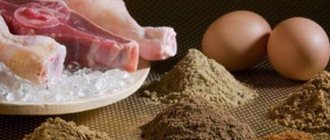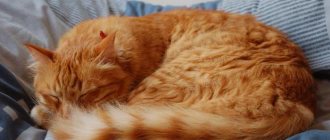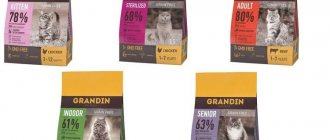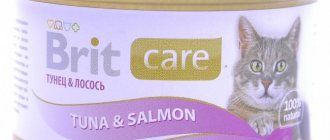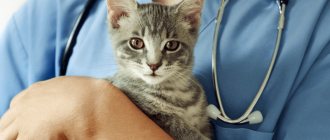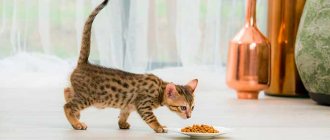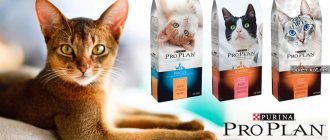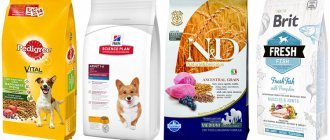The main disadvantages of dry food
Dry food contains too many artificial ingredients. If you carefully study the composition of any dry food, you can find:
- food additives E,
- food gelatin,
- table salt,
- coagulants,
- antioxidants,
- fat burners,
- additives that become poisonous when they accumulate in the animal’s body.
Many additives cause allergies and digestive disorders in pets. Cats and dogs that eat only dry food are more prone to obesity and diabetes.
Every owner has heard about the composition of dry food at least once, but industrial food still has a number of disadvantages.
Water content too low
The pets' diet should contain at least 65%-75% humidity. The body of dogs and cats is accustomed to receiving the required amount of water from food.
The natural prey of cats and dogs contains about 70% liquid
The water content in dry food is less than 10%, which is very little. The pet's body receives much less water than it needs. Cats and dogs that eat dry food drink more water than pets that eat wet food. But at the same time, the former still receive approximately two times less liquid than the latter. Because of this, pets are in a constant state of dehydration and excrete more concentrated urine. This leads to diseases of the lower urinary tract.
Too high carbohydrate content
The carbohydrate content in dry food reaches 50%. In nature, cats and dogs feed on prey: rodents, rabbits, insects and birds. In such a diet, the carbohydrate content does not exceed 2%.
Cats and dogs have specific physiology that matches their natural diet. They do not have the specific enzyme chains that other mammals have, and they do not have amylase, an enzyme in saliva. Therefore, cats and dogs do not digest carbohydrates well.
The level of carbohydrates in dry food increases due to the fact that it contains grains. Carbohydrates are converted into sugar in the body. Excess carbohydrates lead to obesity and diabetes. A number of studies have found that there is a link between the amount of sugar pets consume and serious illnesses, including cancer.
Due to the high sugar and carbohydrate content, L-carnitine is added to the feed. This substance should promote fat burning. But it has not been proven to actually benefit pets.
A person perceives carbohydrates as a source of energy because this is how human physiology works. Cats and dogs are carnivores and get their energy from protein and fat.
Wrong protein
The energy value on dry food packaging can be misleading for pet owners. It seems that the protein content is sufficient, but you need to understand that most of the protein is obtained from plants.
One of the main ingredients in dry food is poultry meal. It consists of crushed feathers, paws, claws, and beaks. It is difficult to detect these components in feed in the form of flour. But because of this component, the quality of the protein is noticeably reduced.
Dry foods often contain corn gluten. This is a protein residue from industrial processing. Corn gluten contains a lot of vegetable protein, which the body of predators does not absorb well. Gluten interferes with bowel movements: it retains indigestible substances in the body. These substances accumulate and become poisonous to the animals. All this creates a significant burden on the kidneys and liver of pets.
Animal and plant proteins differ in amino acid content. For example, cats need taurine, and it is only found in animal protein. Cats and dogs get essential amino acids from meat, fish, eggs and poultry. Legumes, grains and vegetables, which are often included in dry food, cannot provide pets with all the necessary microelements.
Flavoring additives
Dry food itself does not arouse interest in dogs and cats. To increase the appetite of animals, manufacturers add flavorings and flavoring additives. One such supplement is sodium tripolyphosphate. It is an artificial stabilizer, emulsifier and acidity regulator. Manufacturers add artificial vitamins, minerals and amino acids to feed, which reduce the nutritional value of the product. Sodium tripolyphosphate is used to increase it. As already mentioned, artificial additives cause allergies and lead to digestive problems.
Risk of bacterial infection
If the grain from which the food is made has not been stored properly, the dry food may become contaminated with mold, fungus or mycotoxins. For the production of dry food, cheap, low quality raw materials are used, which are not suitable for human consumption. Dry food must be stored correctly: do not allow it to become moist. A humid environment promotes the production of mycotoxins.
Risk of salmonella infection
There have been many cases where manufacturers have recalled dry food because it was contaminated with salmonella. Owners are usually wary of salmonella when it comes to feeding raw meat. As it turned out, the risk of contracting salmonella from dry food is higher. The reason is that people tend to handle it carelessly, but are accustomed to following strict safety rules when handling meat.
The risk of contracting salmonella from raw meat is very low. Especially if human-grade meat is used to prepare the food
Recommendations for feeding dry food
You should give your pet dry food following the recommendations of veterinarians:
- Dry food must be of exceptionally high quality.
- When feeding dry food, it should not be mixed with natural food. You need to choose one thing. This is due to the fact that these foods are digested using different enzymes and different amounts of gastric juice. If you mix both foods, there is a double load on the body, or rather on the work of the liver and stomach.
- Your cat should always have access to clean, fresh water. You cannot replace water with milk. The volume of liquid when a cat eats dry food should be increased at least three times. If the cat drinks very little, then the food must first be slightly moistened.
- It is necessary to adhere to the dosage. It is calculated from the weight of the animal, its age, gender and other indicators. You can calculate the norm yourself according to the instructions on the package. It will definitely indicate how many times a day to feed the animal and in what volume. If you have questions, it is better to contact your veterinarian.
- Do not change food radically. The animal's stomach is quite tender. He gets used to one food. The change of food should be gradual.
Video: how to switch a cat to another food
How does eating dry food affect your pet's health?
You could argue that many cats and dogs eat dry food and are fine. But any living creature seems healthy until external signs of illness appear.
Check out forums for owners of sick pets. All the animals mentioned there were eating dry food and were fine until their owners began to notice signs of illness:
- urination has become difficult due to the blocked urethra;
- pets with cystitis began to experience acute pain, blood began to come out in the urine, and they began to relieve themselves throughout the house;
- pets began to lose their appetite, suffer from food intolerance, intestinal inflammation and asthma;
- kidney stones continued to grow until clinical signs appeared;
- Cancer patients' tumors continued to grow until obvious symptoms appeared.
In other words, diseases can remain undetected for a long time, and all this time develop into more severe forms.
The best dry cat food: read the ingredients
To choose the best dry food, you need to try hard. The fact is that there are a large number of different types of feed on the market. Manufacturers are trying various tricks to attract buyers. They can add unusual ingredients to the composition, make a very bright label with a fancy name and a cute photo of little kittens. All these tricks confuse the buyer. Therefore, it is important, when choosing a particular food, to be guided, first of all, by the set of ingredients.
Information about the composition and percentage must comply not only with Russian, but also with European standards. At the same time, take the trouble to translate the composition of imported food into Russian yourself. There are cases when the translation on the label does not correspond to the original.
If the label indicates that the food is intended for certain types of breeds, you should know that this is a marketing ploy. It's just that for long-haired breeds you need to add more hair removal ingredients. Food for large cats should have more nutrients than their smaller counterparts.
For light-colored cats, it is best to buy food that does not contain bright-colored vegetables, such as tomatoes, carrots, and kelp. Beetroot, on the contrary, improves the quality of feed.
Dry cat food should not have flavors or dyes. Their chemical composition can cause an allergic reaction. Preservatives must be of natural origin. These are vitamins group A, E, C.
The best cat food must contain vitamins, minerals and amino acids, especially lysine.
How to provide your pet with a healthy diet
To keep your pets healthy and happy for many years to come, it is enough to provide them with a healthy diet.
Considering the disadvantages of dry food, create a healthy diet:
- there should be a sufficient amount of liquid in food;
- carbohydrate content should be minimal;
- use animal protein;
- use raw bones for dental health,
- Buy products only from trusted suppliers.
If you are not comfortable preparing healthy food yourself, pay attention to ready-made natural food, for example, SUPERPET.
Remember that a natural diet is the key to your pet’s health.
Did you like the article? Tell your friends:
Comments
What dry food is good for cats?
Cats, as carnivorous predators, need foods high in animal protein, so the more meat they contain, the better. It is not difficult to determine the amount of animal components in food - they should occupy the first places in the list of ingredients, and if the manufacturer indicated their content as a percentage, then even better.
It is also desirable that the feed does not contain grain components, in particular wheat and corn, and that carbohydrate sources in general occupy a minimum volume - no more than 15%. There is no place in cat food for dedicated sources of plant protein, as it is incomplete for these animals.
Thus, the harm of dry cat food is determined by the composition of the product, and if the diet is created correctly and meets the needs of the animals, then this is a convenient and complete type of food on which your pet will live a long life.
Cats need to consume enough moisture through their food.
This is a very important statement because it emphasizes that even low-carbohydrate, grain-free dry foods may not be the optimal source of nutrition for cats. Remember that even cheap canned food is better than any dry food
Compared to other species, cats tolerate lack of water much better.
It is very important to ensure that they drink enough fluids during meals.
In nature, cats obtain most of their fluids from the prey they eat, since their prey is approximately 70 percent water. During the manufacturing process of dry food, the water content in it is reduced to 5-10 percent, while canned food contains about 78 percent water. Clearly, canned foods are better suited to meet fluid needs. Cats fed dry food tend to drink more, but the total amount of liquid they consume is about half that of a wet food diet.
Such a significant underestimation of water consumption contributes to the development of dangerous diseases
kidney and bladder problems, as well as urethral obstruction (blockage of the urethra), which are extremely painful and expensive to treat.
On a wet food diet, the cat's urinary tract is flushed several times a day. This is an important point in the prevention of urinary tract problems, including obstruction, infections, inflammation (cystitis), and chronic kidney disease.
